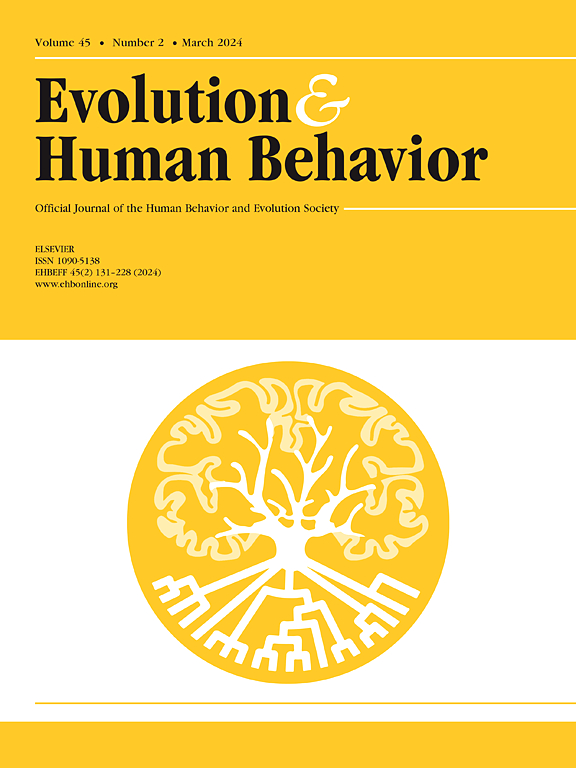野生黑猩猩(泛类人猿)发育过程中母婴互动的基础设施
IF 3
1区 心理学
Q1 BEHAVIORAL SCIENCES
引用次数: 0
摘要
人类社会互动的基础设施可以用几个特征来描述,比如信号和动作的交换、特定的时间关系、定向凝视和身体方向的使用。这些特征在几种不同的语言和文化中是非常一致的,其中一些特征在单词出现之前就已经在母婴互动中出现了。有人认为,人类社会行为背后的独特特征可能早于语言的进化,并在整个灵长类谱系中共享。然而,尽管对非人类灵长类动物的交流进行了数十年的研究,但我们对交流互动的一般特征的理解,更具体地说,它们在交流发展中的作用,仍然令人惊讶地有限。因此,在这里,我们的目标是通过研究在自然环境中生活的我们最亲近的亲戚之一黑猩猩(Pan troglodytes schweinfurthii)的母婴互动,获得更全面的概述。具体而言,我们解决了以下两个研究问题:1)哪些特征构建了母婴互动的主要基础设施?2)哪些因素影响母婴互动的基础结构?为了回答这些问题,我们于2021年2月至2023年2月在乌干达Kibale国家公园的Ngogo社区观察了17对黑猩猩母子的交流互动(0-5岁)(N = 1295观察小时)。我们特别关注了四种不同的互动频繁发生的环境,食物共享,护理,梳理和联合旅行,并调查了人口因素(婴儿的年龄和性别,互动类别)和互动因素(环境,单位类型,转变)的作用。结果表明,母婴互动的特征是信号和动作的均匀交换,反应时间从0秒到2秒不等,并通过高频率的定向凝视和身体方向建立和维持参与框架。婴儿的年龄、性别、互动类别、单元类型和转向对这些特征的影响很小或没有影响。然而,在关节运动环境中,环境对信号频率相对较低、反应时间较快、定向凝视和身体方向频率较低有很强的影响。通过采用比较发展的方法,这项研究强调了人类和黑猩猩之间母婴互动基础设施的共性,这有助于揭示灭绝的人类如何进行社会互动。本文章由计算机程序翻译,如有差异,请以英文原文为准。
Infrastructure of mother-infant interactions across development in chimpanzees (Pan troglodytes) in the wild
The infrastructure underlying human social interaction can be described by several characteristics, such as the exchange of signals and actions, specific temporal relationships, and the use of directed gaze and body direction. These characteristics are remarkably uniform across several different languages, cultures with some of them emerging in mother-infant interactions early in development before the onset of words. It has been suggested that distinct features underlying human social action might have preceded the evolution of language and are shared across the whole primate lineage. However, despite decades of research on nonhuman primate communication, our understanding of general characteristics underlying communicative interactions, and, more specifically, the role they play in the development of communication, remains surprisingly limited. Hence, here we aimed to gain a more comprehensive overview, by studying mother-infant interactions of one of our closest living relatives, the chimpanzee (Pan troglodytes schweinfurthii), living in their natural environments. Specifically, we addressed the following two research questions: 1) Which characteristics built the main infrastructure of mother-infant interactions? 2) Which factors influence the infrastructure of mother-infant interactions? To answer these questions, we observed communicative interactions of a total of 17 chimpanzee mother-infant dyads (0–5 years) in the Ngogo community, Kibale National Park, Uganda between February 2021 and February 2023 (N = 1295 observation hours). We specifically focused on four different contexts where interactions frequently occurred, food sharing, nursing, grooming and joint-travel, and investigated the role of demographic factors (age and sex of the infant, interactant class) and interactional factors (context, unit type, turn transition). The results showed that mother-infant interactions were characterized by an equally distributed exchange of signals and actions, showed response times ranging from zero to two seconds, and involved the establishment and maintenance of participation frameworks through high frequencies of directed gaze and body direction. There was little to no effect of age and sex of the infant, interactant class, unit type and turn transition on these characteristics. However, context had a strong influence with relative lower frequencies of signals, quicker response times, and lower frequencies of directed gaze and body direction observed in the joint-travel context. By taking a comparative developmental approach, this study highlights commonalities in the infrastructure of mother-infant interactions between humans and chimpanzees, which contribute to uncover how extinct humans might have socially interacted.
求助全文
通过发布文献求助,成功后即可免费获取论文全文。
去求助
来源期刊

Evolution and Human Behavior
生物-行为科学
CiteScore
8.30
自引率
9.80%
发文量
62
审稿时长
82 days
期刊介绍:
Evolution and Human Behavior is an interdisciplinary journal, presenting research reports and theory in which evolutionary perspectives are brought to bear on the study of human behavior. It is primarily a scientific journal, but submissions from scholars in the humanities are also encouraged. Papers reporting on theoretical and empirical work on other species will be welcome if their relevance to the human animal is apparent.
 求助内容:
求助内容: 应助结果提醒方式:
应助结果提醒方式:


